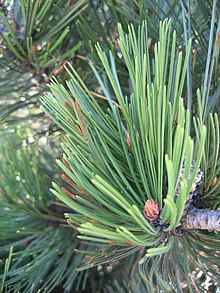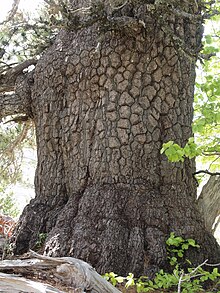Snakeskin jaw
| Snakeskin jaw | ||||||||||||
|---|---|---|---|---|---|---|---|---|---|---|---|---|

Snake skin pines ( Pinus heldreichii var. Leucodermis ) in the Bijela gora |
||||||||||||
| Systematics | ||||||||||||
|
||||||||||||
| Scientific name | ||||||||||||
| Pinus heldreichii | ||||||||||||
| H.Christ |
The snakeskin pine ( Pinus leucodermis ), also called Lorica pine or armored pine , is a species of tree from the genus of pine ( Pinus ) within the pine family (Pinaceae). It occurs in some mountains in the Balkans and in southern Italy. It grows on rocks and, together with the common beech ( Fagus sylvatica ), usually forms the tree line at its locations .
description
Appearance
The snakeskin pine grows as a tree and can reach heights of 10 to 30 meters and diameters of 10 to 40 centimeters at chest height . Specimens can live up to 1,000 years. The trunks are straight on both young and old trees. Cripple growth and shrub forms occur mainly in extreme locations and at the tree line. The dense crown of young trees is light green and pyramidal in shape. Older trees have a darker, less dense, oval crown with branches that are erect at the ends.
Root system
Even very young trees have a long and thin taproot . The tap root penetrates deep into the ground in old trees and ensures that the tree is firmly anchored, especially on stony soils.
bark
Branches have a blue-green, whitish bark . The ash-gray bark of older trees, divided into unevenly trapezoidal plates and covered with small, shiny scales, is striking, reminiscent of the shell of a crocodile and giving it its name. The bark of young trees is silver-gray and smooth. The name "snakeskin pine" is derived from the diamond-shaped, whitish-gray scale bark below the crown.
Wood
Little information is available on the technical properties of the wood . It is said to be less coarse than that of the black pine ( Pinus nigra ). Wood fibers in particular should be resistant to moisture and salty air.
Buds and needles
The egg-shaped and long, pointed buds are brown or brownish red and not resinous. The tip of the bud is whitish and the free, brown scales have silver-white edges.
The stiff needles stand in pairs on short shoots and are between 5 and 10 centimeters long and 1.5 to 3 millimeters wide. The edges of the needle are slightly serrated and the point is piercing. Young needles are light green, older ones are dark green. There are stoma bands on all side surfaces . The needles remain on the tree for between 5 and 6 years.
Flowers, cones and seeds
The snakeskin jaw becomes manable at 15 to 20 years of age . The male cones are light yellow with dark spots. The female cones are purple. The sessile or short-stalked cones mature after two years. The ripe cones have a length of 5 and 10 centimeters and a diameter of 2 and 4 centimeters. Initially the cones are violet in color and turn yellowish brown as they mature. They are usually found individually or in groups of two to three, standing at an angle on the branches.
The gray and elliptical seeds are winged and 4 to 8 millimeters long. You are wrinkled. The thousand grain weight is between 25 and 35 grams.
Chromosome number
The number of chromosomes is 2n = 24.
Distribution and location
The small area of distribution of the snake skin pine consists of a few island-shaped stocks in southern Italy and on the Balkan Peninsula . They can be found in the karst mountains of Orjen in Montenegro , Prenj in Herzegovina , Pirin in Bulgaria and Mount Olympus and Pindus in Greece . It also occurs in Bosnia , Albania , Macedonia and Serbia and grows as an Ice Age relic on the tree line in two places in the southern Apennines in Monte Pollino and Monte Sirene .
The snake-skin pine populates rocky terrain and areas prone to erosion. The locations are mostly influenced by the Mediterranean climate . The annual rainfall can be as mm up to 1,700, most of which falls in the winter months. This precipitation is mostly downpour and can only be absorbed by the ground to a small extent. The species is well adapted to drought and nutrient-poor soils. Mostly alkaline rendzina soils , mostly formed from Regosol , are populated. Depending on the location, they can be found at altitudes between 700 and 2,500 meters.
A typical vegetation unit of this conifer is the snake-skin pine mountain forest (Pinion heldreichii). This azonal , xerobasiphilic forest community, together with the Dinaric karst block dump fir forest (Oreoherzogio-Abietenum illyricae Fuk. ), Is beautifully developed on rocky areas and wind-influenced ridges of skeletal locations, for example in Orjen in Montenegro. In the submontane zone (up to 1,200 meters) of the Italian distribution area, the snake-skin pine forms mixed stands with the field maple ( Acer campestre ), the French maple ( Acer monspessulanum ), the heart-leaved alder ( Alnus cordata ), the hornbeam ( Carpinus betulus ), the manna ash ( Fraxinus ornus ), the European hornbeam ( Ostrya carpinifolia ), the Turkey oak ( Quercus cerris ), the holm oak ( Quercus ilex ) and downy oak ( Quercus pubescens ). In the montane zone (1,200 to 2,000 meters) there are also the common beech ( Fagus sylvatica ), the common ash ( Fraxinus excelsior ) and the aspen ( Populus tremula ). At this altitude you will find the best stands of snakeskin pine in warm, sheltered from wind and snow. This species is undisputedly predominant on rock faces and on ridges exposed to the wind. In the Mediterranean high mountain area (from 2,000 meters) the snake skin pine is the predominant tree species and forms the tree line.
Systematics
The first publication of Pinus heldreichii was done by Konrad Hermann Heinrich Christ . Pinus leucodermis Antoine is a synonym for Pinus heldreichii H.Christ .
In the past, some stocks on the Balkan Peninsula and the occurrences in Italy were regarded as a separate species Pinus leucodermis or as a variety Pinus heldreichii var. Leucodermis (Antoine) Fitschen . Due to the small morphological differences and the results of isoenzymatic comparisons, Pinus leucodermis is no longer classified as a separate species or as a variety, but equated with Pinus heldreichii . Various studies with isoenzymes show that today's stocks are the remains of a much larger population.
use
The snakeskin pine is not a commercial wood species. However, its high adaptability to different locations makes the snakeskin pine interesting for forestry as well as for landscape protection.
Trunk of an old tree, Orjen ( Bijela gora )
Orjen, Revački do
swell
- Schütt, Weisgerber, Schuck, Lang, Stimm, Roloff: Lexicon of Conifers . Nikol, Hamburg 2004, ISBN 3-933203-80-5 , p. 425-432 .
- Description and systematics of Pinus heldreichii at The Gymnosperm Database . (English)
- Milorad Janković: Pregled asocijacija munikovih šuma (Pinetum heldreichii) u Jugoslaviji . In: Miodrag Glisić, Djordje Panić (eds.): Zbornik radova . Simpozijum o munici: Zavod za šumarstvo Peć. Dečani (Kosovo), September 4-7, 1972 (= Simpozium mbi arnenin = Symposium de Pinus heldreichii ). Inst. Za šummarstvo i drvnu industriju, Belgrade 1975, OCLC 254907333 , p. 146-158 .
Individual evidence
- ^ Tropicos. tropicos.org
- ↑ Milorad M. Janković: Peucedano-Pinetum heldreichii M. Jank., Nova asocijacija subendemi nog balkanskog bora Pinus heldreichii na Orjenu (predhodno saopštenje). In: Glasnik Bot. Zavoda i Bašte Univ. Beograd. Volume 2, No. 1-4, 1967, pp. 203-206 ( botanicaserbica.bio.bg.ac.rs PDF).
- ↑ Rafaël Govaerts (ed.): Pinus. In: World Checklist of Selected Plant Families (WCSP) - The Board of Trustees of the Royal Botanic Gardens, Kew . Retrieved April 16, 2019.
Web links
- Thomas Meyer: Data sheet with identification key and photos at Flora-de: Flora von Deutschland (old name of the website: Flowers in Swabia )
- Pinus heldreichii in the endangered Red List species the IUCN 2008. Posted by: Conifer Specialist Group, 1998. Retrieved on January 2 of 2009.








